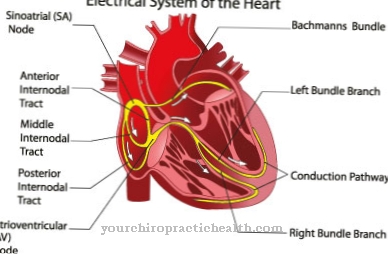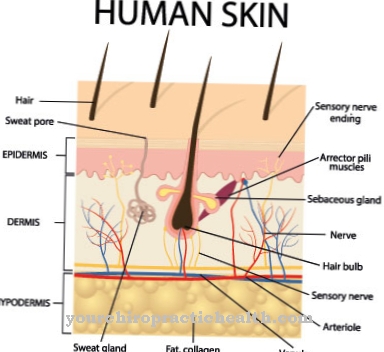Of the Vaginismus or Vaginal cramp is the sudden, uncontrollable and painful cramping of muscles in the area of the pelvic floor and vagina. In order to break a negative cycle between pain and the fear of another spasm, an early search for the causes is necessary. These are either physical or, in most cases, psychological. The therapy depends on the respective causes, with psychological triggers often an individual combination of psychotherapy, relaxation exercises, pelvic floor training and the use of vaginal dilators to treat vaginismus.
What is vaginismus?
.jpg)
Vaginismus (vaginal spasm) refers to the involuntary and extremely painful cramping of the muscles of the pelvic floor and parts of the vagina.
The result of the sudden, extreme tension is a significant narrowing of the vagina, with the consequence that gynecological examinations, sexual intercourse or the insertion of objects (tampon, fingers) are associated with severe pain or even impossible - even if the insertion is done by the woman it is asked for. As a rule, she herself cannot influence the reflexively occurring muscle spasm.
Since recurring vaginal cramps represent a psychological burden for the affected woman as well as a massive restriction in their sexuality and thus their quality of life, due to the growing fear of expectation, a prompt research into the cause or the treatment of vaginismus should be initiated through a trusting doctor's visit.
causes
Of the Vaginismus belongs to the class of painful sexual dysfunctions and can have both physical and psychological causes.
In the physical area, for example, a hymen that is difficult to penetrate, the vagina narrowed by a septum, infections, hormonal causes or functional disorders of the pelvic floor muscles are among the classic triggers. The psychological causes include a traumatic sexual experience, a negative birth experience or an upbringing that degrades sexuality.
In medicine, a distinction is also made between primary vaginismus - here the woman was never able to insert anything into the vagina - and the defensive reaction of secondary vaginismus triggered by a negative event.
The attack-like occurrence of the spasm and the pronounced pain symptoms cause most women an intense fear of anticipation with regard to the next attack, so that the psychological component of vaginismus must always be taken into account, even with physical causes.
Symptoms, ailments & signs
Vaginismus describes the involuntary, spasmodic narrowing of a woman's vagina. The extent of the cramps can vary greatly. Some women tense up during an examination at the gynecologist, while other women rarely experience cramping. The spasm usually shows up in the outer third of the vagina when the penis penetrates. In some people affected, however, it also comes to a vaginal spasm and in some people affected, the pelvic floor muscles can cramp.
The spasm is accompanied by a sharp, throbbing pain and a strong burning sensation. Since vaginismus occurs most frequently during sex, affected women experience great suffering and avoid sexual contact. Since vaginismus can also be caused by inserting a tampon in some cases, secondary symptoms such as poor hygiene or inflammation can occur.
Vaginismus is not only associated with a panic fear of the pain that occurs, but is also often a taboo subject. Many women are afraid to speak to their doctors about it. In some cases, gynecologists are also avoided outright, as the examination can cause cramping. In some cases, vaginismus can indicate a psychological cause, such as abuse. Such psychological causes can be inquired about in careful discussions with the doctor.
Diagnosis & course
Important building block for the diagnosis of the Vaginismus is the description of the symptoms of vaginal spasm by the patient. Whether a gynecological examination of the affected person - for example to rule out birth injuries, constrictions or infections - is even possible depends on the individual extent of the respective disorder.
Psychological causes such as a traumatic experience (rape, abuse, painful gynecological examination) are discussed in careful discussions with the doctor or psychologist. However, the prerequisite for diagnosis and treatment is that the woman turns to her doctor and possibly also to her partner about the supposedly taboo subject of vaginismus.
This is the only way to break the vicious circle of anxiety and painful cramps and to avoid permanent sexual disorders and the possible negative effects of vaginismus on the partnership.
Complications
Vaginismus almost always affects sexual relationships, as penetration is impossible or painful. In some cases, fear or aversion to sexual situations is added.
Women in a partnership may put themselves under psychological pressure to "function". However, this can actually make the vaginismus worse. Relationship conflicts are also possible if the other partner's sexual needs remain unsatisfied or if the partner does not understand the complaints sufficiently.
Some women who suffer from vaginismus therefore avoid romantic relationships and withdraw. Often this withdrawal is not voluntary and is characterized by strong feelings such as loneliness. Affective disorders such as depression are thereby favored.
Shame and feelings of guilt are common consequences of vaginismus. In addition, self-esteem often drops. Post-traumatic stress disorder or other mental illnesses are possible if the vaginismus is due to trauma or other stress factors.
Medical complications in vaginismus arise almost exclusively indirectly. The vaginismus can be so severe that certain gynecological examinations are not possible. If an affected woman then avoids visiting the gynecologist, she may postpone treatment of other complaints. This can lead to further complications, for example in the case of infections that are not treated early due to avoidant behavior.
When should you go to the doctor?
Vaginismus is painful and can make a normal sex life almost impossible for affected women. It is unlikely that vaginismus will improve on its own or that the woman will be able to develop mechanisms to deal with it without help. Therefore, the gynecologist should be consulted immediately when the first case occurs. Because vaginismus can be associated with traumatic experiences, a woman can also seek help from a treating psychologist if she notices the symptoms.
The doctor's visit must not be made depending on the age of the woman concerned or her sexual experience. It may be that a young girl develops vaginismus and she notices it during the first sexual experiences - just as it may be that a woman suddenly suffers from vaginismus after giving birth because she has not processed the experiences of the birth.
In some cases, discomfort during intercourse appears to have no apparent cause, but that does not mean that it cannot still be vaginismus. Only a gynecologist can detect this, but the earlier vaginismus can be detected, the sooner it can be treated. The duration of the treatment will take some time, but the more time the patient with vaginismus becomes uncomfortable before her first appointment with the doctor.
Treatment & Therapy
An effective treatment for the Vaginismus depends on the cause of the vaginal cramps. In the case of physical causes, this includes, for example, the surgical cleavage of a fixed hymen or the removal of a congenital septum in the vagina.
If a psychologically sound illness is suspected, a combination of effective therapeutic measures is often used to gradually reduce the frequency of seizures and the patient's anxiety. Often the step of confiding in the doctor and partner already brings with it an initial relief for those affected when they experience understanding for their situation. In the area of vaginal spasm therapy, vaginal dilators are particularly successful. These are smooth, conical rods in various sizes, with the help of which the woman can carefully expand her vagina.
This treatment can be supported by classic relaxation methods or biofeedback, but also by targeted pelvic floor training, in which the woman can regain control over her own body by tensing and relaxing the muscles concerned. In the case of massive psychological triggers, accompanying psychotherapy is advisable, which serves to process the traumas experienced. If the relationship has a serious impact, special couple or sex therapies can be helpful against vaginismus.
Outlook & forecast
Vaginismus prevents those affected from having a fulfilling sex life. Unfortunately, painful vaginal cramps are a condition that will not improve on its own. Since the most common cause of vaginismus are psychological triggers, the condition cannot improve until the cause is identified and treated.
Depending on what triggers the vaginal cramps, it may take several sessions with a sex psychologist before the woman notices a noticeable improvement. Even if there is a purely physical cause or the emotional triggers can be improved through exercises and training with dilators, it takes time. With this method, the woman gradually inserts wider and wider objects into the vagina and works on consciously relaxing. This will allow them to have a normal and fulfilling sex life over time.
What can prevent the success of the treatment is pressure from the partner or from oneself. It is understandable, but absolutely counterproductive if the partner or the patient themselves become impatient and thereby put themselves under even more pressure. In the worst case, this can aggravate the vaginismus already present and reverse treatment successes that have already been achieved. Involving the partner in the diagnosis and treatment, on the other hand, ensures that he or she can develop understanding and contribute to improvement through patience.
prevention
Because of the multitude of causes and its sudden occurrence, that is Vaginismus a disorder that can hardly be prevented. In the physical area, regular gynecological examinations as well as good hygiene are options for diagnosing or avoiding diseases that favor vaginal cramps at an early stage. In the psychological area, priority should be given to systematically working through negative events relating to sexuality or childbirth in order to counteract the emergence of vaginismus as a result of trauma.
Aftercare
After a vaginismus (vaginal spasm), individual follow-up care is often helpful. The reason for the cramp is important for the design of personal aftercare. Physical causes are looked after by the gynecologist, psychological causes often require the trustful cooperation of the doctor, psychologist, the person concerned and their partner.
The fear of a new divorce fight can significantly limit a woman's sex life and even represent a reason for another vaginismus. Therefore, it is good to know the cause of individual vaginismus and work on it. If it is certain positions during sexual intercourse that obviously trigger the vaginal spasm, it is easy to do without it in the follow-up care.
If the fear of intrusion has become too great, the woman can gradually approach this situation again with a finger or a vibrator. Often there are emotional reasons that are responsible for the vaginal spasm. Follow-up care should begin here very carefully. Conversations with psychologists help deal with problems. Self-help groups offer an exchange with like-minded people.
Conversations with the partner contribute to better mutual understanding and reduce fears. The woman's ability to relax should also be encouraged in aftercare. This is possible with progressive muscle relaxation or yoga.
You can do that yourself
In many cases, a vaginal spasm can be traced back to a psychological trigger. Internalizing this and assuming that there is no organic disorder is a good first step. In the case of physically caused vaginismus, e.g. a narrowed vagina or inflamed tissue, treatment for the cause is necessary.
A good way to gain body awareness in the genital area and gain more anatomical knowledge of the sexual organs is to practice a good pelvic floor muscle exercise program. There are group and home courses that can be completed with or without a partner.
Insofar as vaginismus is not based on trauma of a psychological or physical nature, a suitable means of relaxation can be used, in which the person concerned concentrates fully on himself and her body. In the case of situational vaginismus - i.e. a vaginal spasm that always occurs in the same situation - it can help to deal with the supposed trigger more closely.
Furthermore, masturbation exercises, in which the movement of the vagina is caused by movement of the pelvis, are said to have good results in overcoming a vaginal spasm. It is important that the control comes from the sex organ and not from fingers or the like. This learns how the vagina behaves when an attempt is made to penetrate it. Taking into account your own physical limits, these can also lead to a certain desensitization and stretching of the tissue if the vagina is too narrow. However, the effect is limited if the vagina is too small.


.jpg)


.jpg)


















.jpg)



